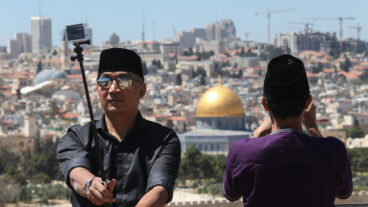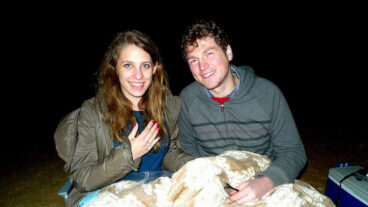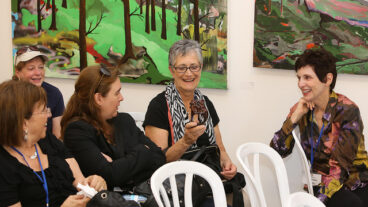When leading environmentalist Alon Tal opened the first Israel-hosted UN Conference on Deserts and Desertification, he discarded his necktie, setting a typically Israeli tone: “I did my part by wearing it; I’m getting comfortable and I encourage you all to do the same,” he told the roomful of over 200 conference attendees.
They had come from thirty different countries to the Negev desert to swap knowledge, assess domestic policies and address the urgent spread of global drylands. Jointly hosted by the United Nations Convention to Combat Desertification (UNCCD) and Israel’s Jacob Blaustein Institutes for Desert Research at Ben-Gurion University of the Negev, participants sat in on lectures and visited research facilities over a period of four days.
“We need to learn from the resilience of Israel in developing drylands,” Deputy Secretary General of the United Nations Convention to Combat Desertification (UNCCD), Ambassador Gregoire de Kalbermatten told attendees in opening session remarks.
Series of panels and discussions integrated some of the world’s leading international desertification experts including Ghana Fisheries Minister Gladys Asmah, Jordanian Director General of Sustainable Development Dr. Khaled Nassar and India’s Dr. Gurbachan Singh, Director of the country’s Central Soil Salinity Research Institute. Experts and representatives from Mongolia, Uzbekistan, Uganda, Australia, Mexico and other countries were on hand at opening day sessions.
“Why are we here?” Ambassador Kalbermatten continued in his address. “Because the link between conflict in this part of the world can be viewed in the broader link between natural resources and ecology. If current climate scenarios of change, growth demographics, consumption patterns and poverty continue, the fight in the 21st century will be over water, not oil.”
The United Nations General Assembly declared 2006 the International Year of Deserts and Desertification to help prevent the exacerbation of global desertification and to support public awareness activities related to desertification and land degradation.
The year’s main objective is to get the message across that desertification is a major threat to humanity compounded by both climate change and loss of biological diversity.
Drylands make up over 40% of the world?s surface and are inhabited by some of the world?s lowest income populations. “Israel’s knowledge of dryland agriculture could be of great value to some of the world’s poorest,” a UN statement issued at the conference relayed.
“I am here because I am specifically interested in issues of gender and pastoral lifestyle. I am a Massai and there are tremendous conflicts between African farmers and pastoral groups over eco-balance and land degradation. I hope to learn from the experts here,” Josephine Simon, Community Conservation Officer of Tanzania’s African Wildlife Foundation told ISRAEL21c.
Panel sessions during the four day conference addressed issues of Dryland biodiversity and the ecosystem, agro forestry, management of degraded lands and impact of climate change on drylands.
“One third of humanity lives in drylands,” explained Israel’s UNCCD Focal Point Ambassador and Ecology Professor Uriel Safriel. “So this presents challenges: Erosion, soil salinization and loss of vegetation cover. At the same time, however, there are opportunities: Agriculture can be replaced with aquaculture, eco-tourism can be promoted and urban development like in Las Vegas or Riyadh can be encouraged.”
Israel has been a global leader in innovative desert technologies introducing drip irrigation, desert fish farming techniques, algae cultivation and de-salinization to the world.
Beyond academic and professional proceedings, conference goers were treated to a sundown tour of a 3rd Century BCE Nabatean desert caravan site and 6th century Byzantine community remains on conference opening day. The tour was part of a larger thematic plan to expose conference goers to ancient desert cultures, migration habits and water cistern preservation techniques. “This is simply amazing in terms of history and the water issues we face now,” Kenya Development Services Executive Director Silvanus Malaho told ISRAEL21c. “The water preservation and construction systems here were elaborate.”
During the 4-day conference, attendees also visited solar energy and development centers, desert eco-tourism sites, brackish water fisheries and algae growing centers.
Although Arab world delegates were mostly absent, Jordan was represented by Dr. Khaled Nasser of The Jordanian Sustainable Development Society. Palestinian Authority General Director of Water & Environmental Development Nader al_Khateeb told 21c that despite the political climate, “even politicians who can’t agree on major issues agree on environment. It affects across boundaries. If there is a will, we can continue working for the environment,” he told 21c.
UNCCD delegate Uriel Safriel summarized by telling ISRAEL21c that the point of the conference was to find opportunities. “The message coming from here is that desert drylands are opportunities for mankind, not curses. Following Israel’s lead, we can use deserts for the betterment of mankind.”












